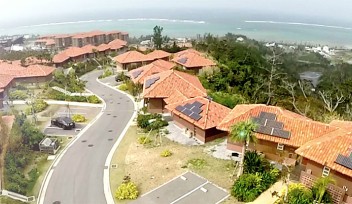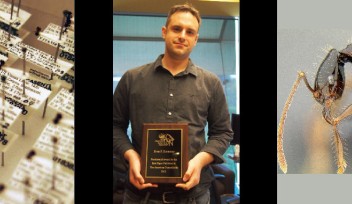Changing the World with Open Energy System

OIST hosted its first symposium of the year, “The 1st International Symposium on Open Energy Systems” on January 14th and 15th. During the two-day symposium, jointly organized with Sony Computer Science Laboratories, Inc. (Sony CSL), participants from various sectors, including government, industry, and academia, gathered to discuss the world's energy needs and learn about one possible solution - the Open Energy System (OES). OES is an experimental project being conducted at OIST by Prof. Hiroaki Kitano of the OIST Open Biology Unit, members of Sony CSL and the local contractor Okisokou.
The OES project, which started in September 2013, put solar panels on the roofs of neighboring faculty houses and equipped each home with an energy server comprising a new type of battery and power management equipment. The houses are connected through a direct current (DC) microgrid which allows energy to be distributed effectively among these households, thus ensuring a stable power supply, regardless of weather or residents' lifestyles. For example, OES can leverage residents' lifestyle differences by transferring surplus energy produced at a house whose occupants are often away to a house with more activity and greater energy needs.
The symposium also discussed the efficiencies and prospects offered by developing renewable energy systems and so-called “Smart Communities.” A Smart Community uses a next-generation electrical grid to optimize energy production and consumption by monitoring and adjusting the exchange between power plants and homes. In combination with such Smart Communities, the use of renewable energy systems is also expected to play a large role in addressing environmental and health issues, not just in next-generation infrastructure of developed nations but also as an important solution in developing countries. In Japan, pilot programs to test the potential of smart communities are being run in four cities. Participants of the symposium agreed that demonstrating the advantages of these new systems to companies and local communities would be necessary in gaining support for their wide use.
Prof Kitano called on participants to “bring about change in the world… and act on our resolution, starting here from Okinawa.” He went on to stress that developing the next generation of energy systems is an important priority, with benefits for the environment, the economy, and everyday life, and the development of an effective system requires seamless collaboration among different sectors. In closing, OIST President Jonathan Dorfan explained that the OES is a unique project, which implements both basic research and technology development at the same time. He concluded that OIST will continue to act as an innovative R&D platform by partnering with other research institutes and companies to develop the renewable energy systems of the future.
Specialty
Research Unit
For press enquiries:
Press Inquiry Form


















